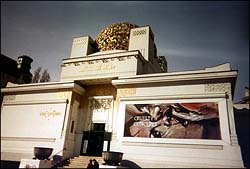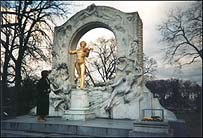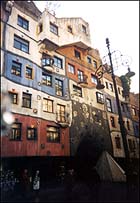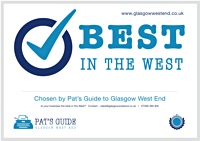Helen Rose's Hill Walking Diary. A Trip to Vienna. March, 2002

Vienna. A Walk on the Ringstrasse
Much as I love the hills and the great outdoors, I like a cultural break in a city. This is usually taken in the winter to avoid the inevitable queues for galleries and museums. It also avoids all the touristy stalls and crowds and the city can be seen at its best with the residents going about their daily business.
This year our trip was to Vienna and we were lucky to have a window in the weather with clear skies, excellent for taking photographs of the many beautiful and ornate buildings. There are masses of things to do and see in Vienna and five days was not long enough to take it all in. We limited sightseeing to only a few interesting things every day to avoid cultural overload. What follows is only a snapshot of a very attractive city.
The public transport system in Vienna is second to none with a network of trams, underground trains and buses linking all the major attractions. It is very easy to get around independently as all the transport systems are clearly marked and a purchased Vienna card allows unlimited travel on public transport for 72 hours. However, if you want to walk you can hop on and off the trams which are every few minutes. Miss one and another will be along shortly!

The Ringstrasse was planned by Emperor Franz Josef 1 as a boulevard befitting an imperial capital with a horseshoe incorporating 12 major public buildings and completed in 1890 over a period of thirty years. Today, the Ringstrasse looks pretty much as it did in the last days of the Habsburgs.
Starting in an anti clockwise direction, we walked to the Rathaus (City Chambers) where an outdoor ice rink was buzzing with children in the square in front of the building with a giant screen showing the Winter Olympics. Austria had just won a gold for skiing so the glorious moment was being replayed on the screen. The Rathaus is Flemish Gothic style planned to conjure up municipal wealth and independence. There are other buildings on the square of architectural interest but I won't go in to detail. You can buy a good guide book if you are interested!
Onto the Kuntsthistorisches Museum for a look at the paintings by Pieter Bruegel. The museum building has a sumptously decorated main foyer and staircase. The Bruegel paintings are rhe largest collection in the world and provide a fascinating insight into life in the sixteenth century. I particularly liked the painting of Childrens Games where over ninety games are depicted, many still popular with children today.
Across the road in the Hofburg Palce there were more sumptous interiors but I was particularly impressed by the rooms of Empress Elisabeth, the wife of Franz Josef 1, who was considered eccentric for that time and had wooden gym apparatus on which she exercised every day. She was known to swing from the wooden rings on the gilded panel above the doorway while dressed in full skirts which were the fashion of the nineteenth century!.
We walked on to the Opera House which is the busiest pedestrian section of the Ringstrasse. It was time to visit a typical Viennese Cafe for coffee and an apple strudel. Unfortunately, the evening performance at the Opera House of the Marriage of Figaro was sold out. I will need to book in advance the next time. After all, it is the home of Mozart. Incidentally, a visit to the Figaro House where Mozart lived is a rewarding experience as it documents his life and also allows access to typical housing of that time with an internal open stairway to access the flat. The house is just behind St Stephens Cathedral in the centre of the Horseshoe.

Back to the Ringstrasse and Katrlsplatz to see the Secession Building which includes Gustav Klimt's Beethoven Frieze prepared for the exhibition of 1902. The Secession was a group of breakaway artists from the establishment who promoted Art Nouveau in 1897. On the trail of more modern art, we travelled by tram to the Hundertwasserhaus in a neighbouring district where in 1983 the ageing hippy, Friedensreich Hundertwasser, was commissioned to redesign some run down Council Housing. The results are fascinating with every architectural style possible from oriel windows, loggias, ceramic pillars , glass features to a gilded onion dome all in brightly coloured textures. A joy to behold!
I can't finish without a mention of the substantial Austrian meals including dumplings and sauerkraut and the glasses of foaming beer. Good hearty food for walking around Vienna the following day!
Coming attractions: Visit to the island of Rum, weekend in Braemar and a walk in Brazil.
Thanks to Frances Rickus for the photographs.







